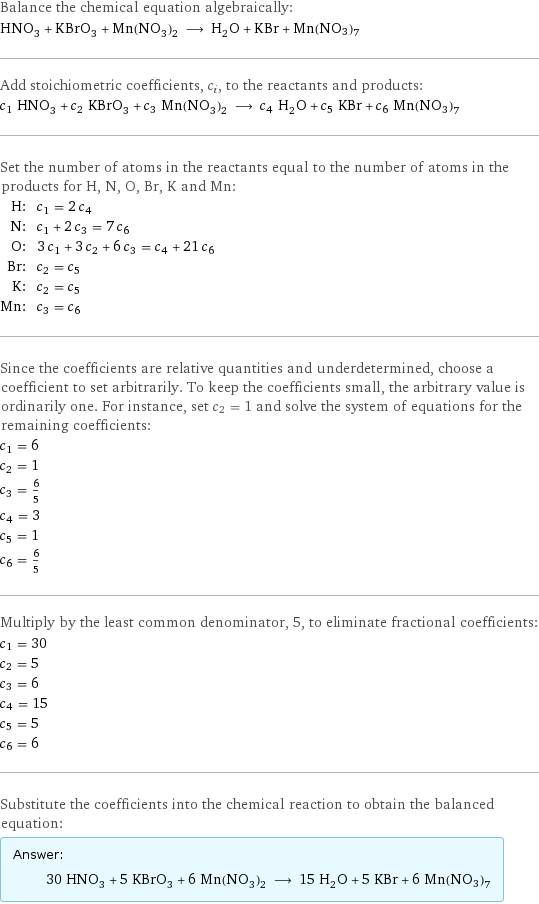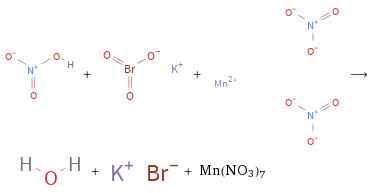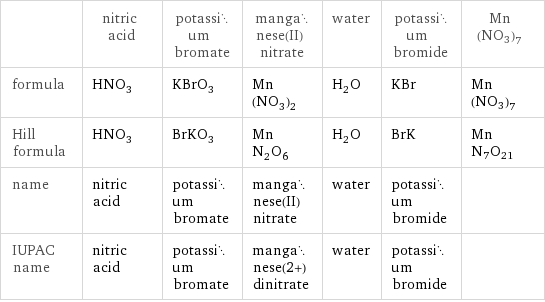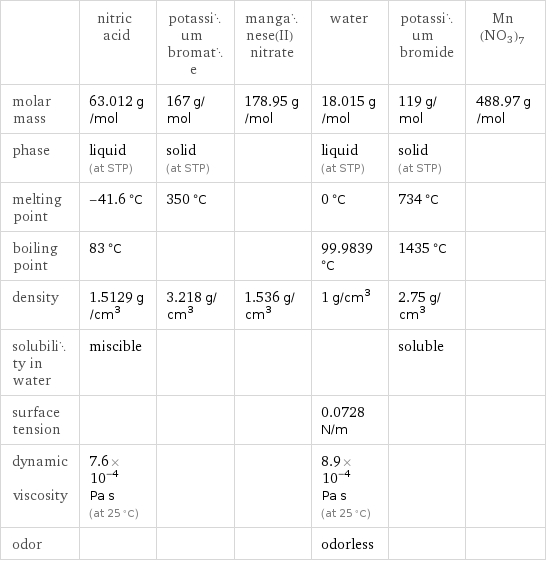Input interpretation

HNO_3 nitric acid + KBrO_3 potassium bromate + Mn(NO_3)_2 manganese(II) nitrate ⟶ H_2O water + KBr potassium bromide + Mn(NO3)7
Balanced equation

Balance the chemical equation algebraically: HNO_3 + KBrO_3 + Mn(NO_3)_2 ⟶ H_2O + KBr + Mn(NO3)7 Add stoichiometric coefficients, c_i, to the reactants and products: c_1 HNO_3 + c_2 KBrO_3 + c_3 Mn(NO_3)_2 ⟶ c_4 H_2O + c_5 KBr + c_6 Mn(NO3)7 Set the number of atoms in the reactants equal to the number of atoms in the products for H, N, O, Br, K and Mn: H: | c_1 = 2 c_4 N: | c_1 + 2 c_3 = 7 c_6 O: | 3 c_1 + 3 c_2 + 6 c_3 = c_4 + 21 c_6 Br: | c_2 = c_5 K: | c_2 = c_5 Mn: | c_3 = c_6 Since the coefficients are relative quantities and underdetermined, choose a coefficient to set arbitrarily. To keep the coefficients small, the arbitrary value is ordinarily one. For instance, set c_2 = 1 and solve the system of equations for the remaining coefficients: c_1 = 6 c_2 = 1 c_3 = 6/5 c_4 = 3 c_5 = 1 c_6 = 6/5 Multiply by the least common denominator, 5, to eliminate fractional coefficients: c_1 = 30 c_2 = 5 c_3 = 6 c_4 = 15 c_5 = 5 c_6 = 6 Substitute the coefficients into the chemical reaction to obtain the balanced equation: Answer: | | 30 HNO_3 + 5 KBrO_3 + 6 Mn(NO_3)_2 ⟶ 15 H_2O + 5 KBr + 6 Mn(NO3)7
Structures

+ + ⟶ + + Mn(NO3)7
Names

nitric acid + potassium bromate + manganese(II) nitrate ⟶ water + potassium bromide + Mn(NO3)7
Equilibrium constant
![Construct the equilibrium constant, K, expression for: HNO_3 + KBrO_3 + Mn(NO_3)_2 ⟶ H_2O + KBr + Mn(NO3)7 Plan: • Balance the chemical equation. • Determine the stoichiometric numbers. • Assemble the activity expression for each chemical species. • Use the activity expressions to build the equilibrium constant expression. Write the balanced chemical equation: 30 HNO_3 + 5 KBrO_3 + 6 Mn(NO_3)_2 ⟶ 15 H_2O + 5 KBr + 6 Mn(NO3)7 Assign stoichiometric numbers, ν_i, using the stoichiometric coefficients, c_i, from the balanced chemical equation in the following manner: ν_i = -c_i for reactants and ν_i = c_i for products: chemical species | c_i | ν_i HNO_3 | 30 | -30 KBrO_3 | 5 | -5 Mn(NO_3)_2 | 6 | -6 H_2O | 15 | 15 KBr | 5 | 5 Mn(NO3)7 | 6 | 6 Assemble the activity expressions accounting for the state of matter and ν_i: chemical species | c_i | ν_i | activity expression HNO_3 | 30 | -30 | ([HNO3])^(-30) KBrO_3 | 5 | -5 | ([KBrO3])^(-5) Mn(NO_3)_2 | 6 | -6 | ([Mn(NO3)2])^(-6) H_2O | 15 | 15 | ([H2O])^15 KBr | 5 | 5 | ([KBr])^5 Mn(NO3)7 | 6 | 6 | ([Mn(NO3)7])^6 The equilibrium constant symbol in the concentration basis is: K_c Mulitply the activity expressions to arrive at the K_c expression: Answer: | | K_c = ([HNO3])^(-30) ([KBrO3])^(-5) ([Mn(NO3)2])^(-6) ([H2O])^15 ([KBr])^5 ([Mn(NO3)7])^6 = (([H2O])^15 ([KBr])^5 ([Mn(NO3)7])^6)/(([HNO3])^30 ([KBrO3])^5 ([Mn(NO3)2])^6)](../image_source/05a5d928ef2812f6f67fe8c403f04569.png)
Construct the equilibrium constant, K, expression for: HNO_3 + KBrO_3 + Mn(NO_3)_2 ⟶ H_2O + KBr + Mn(NO3)7 Plan: • Balance the chemical equation. • Determine the stoichiometric numbers. • Assemble the activity expression for each chemical species. • Use the activity expressions to build the equilibrium constant expression. Write the balanced chemical equation: 30 HNO_3 + 5 KBrO_3 + 6 Mn(NO_3)_2 ⟶ 15 H_2O + 5 KBr + 6 Mn(NO3)7 Assign stoichiometric numbers, ν_i, using the stoichiometric coefficients, c_i, from the balanced chemical equation in the following manner: ν_i = -c_i for reactants and ν_i = c_i for products: chemical species | c_i | ν_i HNO_3 | 30 | -30 KBrO_3 | 5 | -5 Mn(NO_3)_2 | 6 | -6 H_2O | 15 | 15 KBr | 5 | 5 Mn(NO3)7 | 6 | 6 Assemble the activity expressions accounting for the state of matter and ν_i: chemical species | c_i | ν_i | activity expression HNO_3 | 30 | -30 | ([HNO3])^(-30) KBrO_3 | 5 | -5 | ([KBrO3])^(-5) Mn(NO_3)_2 | 6 | -6 | ([Mn(NO3)2])^(-6) H_2O | 15 | 15 | ([H2O])^15 KBr | 5 | 5 | ([KBr])^5 Mn(NO3)7 | 6 | 6 | ([Mn(NO3)7])^6 The equilibrium constant symbol in the concentration basis is: K_c Mulitply the activity expressions to arrive at the K_c expression: Answer: | | K_c = ([HNO3])^(-30) ([KBrO3])^(-5) ([Mn(NO3)2])^(-6) ([H2O])^15 ([KBr])^5 ([Mn(NO3)7])^6 = (([H2O])^15 ([KBr])^5 ([Mn(NO3)7])^6)/(([HNO3])^30 ([KBrO3])^5 ([Mn(NO3)2])^6)
Rate of reaction
![Construct the rate of reaction expression for: HNO_3 + KBrO_3 + Mn(NO_3)_2 ⟶ H_2O + KBr + Mn(NO3)7 Plan: • Balance the chemical equation. • Determine the stoichiometric numbers. • Assemble the rate term for each chemical species. • Write the rate of reaction expression. Write the balanced chemical equation: 30 HNO_3 + 5 KBrO_3 + 6 Mn(NO_3)_2 ⟶ 15 H_2O + 5 KBr + 6 Mn(NO3)7 Assign stoichiometric numbers, ν_i, using the stoichiometric coefficients, c_i, from the balanced chemical equation in the following manner: ν_i = -c_i for reactants and ν_i = c_i for products: chemical species | c_i | ν_i HNO_3 | 30 | -30 KBrO_3 | 5 | -5 Mn(NO_3)_2 | 6 | -6 H_2O | 15 | 15 KBr | 5 | 5 Mn(NO3)7 | 6 | 6 The rate term for each chemical species, B_i, is 1/ν_i(Δ[B_i])/(Δt) where [B_i] is the amount concentration and t is time: chemical species | c_i | ν_i | rate term HNO_3 | 30 | -30 | -1/30 (Δ[HNO3])/(Δt) KBrO_3 | 5 | -5 | -1/5 (Δ[KBrO3])/(Δt) Mn(NO_3)_2 | 6 | -6 | -1/6 (Δ[Mn(NO3)2])/(Δt) H_2O | 15 | 15 | 1/15 (Δ[H2O])/(Δt) KBr | 5 | 5 | 1/5 (Δ[KBr])/(Δt) Mn(NO3)7 | 6 | 6 | 1/6 (Δ[Mn(NO3)7])/(Δt) (for infinitesimal rate of change, replace Δ with d) Set the rate terms equal to each other to arrive at the rate expression: Answer: | | rate = -1/30 (Δ[HNO3])/(Δt) = -1/5 (Δ[KBrO3])/(Δt) = -1/6 (Δ[Mn(NO3)2])/(Δt) = 1/15 (Δ[H2O])/(Δt) = 1/5 (Δ[KBr])/(Δt) = 1/6 (Δ[Mn(NO3)7])/(Δt) (assuming constant volume and no accumulation of intermediates or side products)](../image_source/5d837fb043c2d84ef8c7599c533cb9de.png)
Construct the rate of reaction expression for: HNO_3 + KBrO_3 + Mn(NO_3)_2 ⟶ H_2O + KBr + Mn(NO3)7 Plan: • Balance the chemical equation. • Determine the stoichiometric numbers. • Assemble the rate term for each chemical species. • Write the rate of reaction expression. Write the balanced chemical equation: 30 HNO_3 + 5 KBrO_3 + 6 Mn(NO_3)_2 ⟶ 15 H_2O + 5 KBr + 6 Mn(NO3)7 Assign stoichiometric numbers, ν_i, using the stoichiometric coefficients, c_i, from the balanced chemical equation in the following manner: ν_i = -c_i for reactants and ν_i = c_i for products: chemical species | c_i | ν_i HNO_3 | 30 | -30 KBrO_3 | 5 | -5 Mn(NO_3)_2 | 6 | -6 H_2O | 15 | 15 KBr | 5 | 5 Mn(NO3)7 | 6 | 6 The rate term for each chemical species, B_i, is 1/ν_i(Δ[B_i])/(Δt) where [B_i] is the amount concentration and t is time: chemical species | c_i | ν_i | rate term HNO_3 | 30 | -30 | -1/30 (Δ[HNO3])/(Δt) KBrO_3 | 5 | -5 | -1/5 (Δ[KBrO3])/(Δt) Mn(NO_3)_2 | 6 | -6 | -1/6 (Δ[Mn(NO3)2])/(Δt) H_2O | 15 | 15 | 1/15 (Δ[H2O])/(Δt) KBr | 5 | 5 | 1/5 (Δ[KBr])/(Δt) Mn(NO3)7 | 6 | 6 | 1/6 (Δ[Mn(NO3)7])/(Δt) (for infinitesimal rate of change, replace Δ with d) Set the rate terms equal to each other to arrive at the rate expression: Answer: | | rate = -1/30 (Δ[HNO3])/(Δt) = -1/5 (Δ[KBrO3])/(Δt) = -1/6 (Δ[Mn(NO3)2])/(Δt) = 1/15 (Δ[H2O])/(Δt) = 1/5 (Δ[KBr])/(Δt) = 1/6 (Δ[Mn(NO3)7])/(Δt) (assuming constant volume and no accumulation of intermediates or side products)
Chemical names and formulas

| nitric acid | potassium bromate | manganese(II) nitrate | water | potassium bromide | Mn(NO3)7 formula | HNO_3 | KBrO_3 | Mn(NO_3)_2 | H_2O | KBr | Mn(NO3)7 Hill formula | HNO_3 | BrKO_3 | MnN_2O_6 | H_2O | BrK | MnN7O21 name | nitric acid | potassium bromate | manganese(II) nitrate | water | potassium bromide | IUPAC name | nitric acid | potassium bromate | manganese(2+) dinitrate | water | potassium bromide |
Substance properties

| nitric acid | potassium bromate | manganese(II) nitrate | water | potassium bromide | Mn(NO3)7 molar mass | 63.012 g/mol | 167 g/mol | 178.95 g/mol | 18.015 g/mol | 119 g/mol | 488.97 g/mol phase | liquid (at STP) | solid (at STP) | | liquid (at STP) | solid (at STP) | melting point | -41.6 °C | 350 °C | | 0 °C | 734 °C | boiling point | 83 °C | | | 99.9839 °C | 1435 °C | density | 1.5129 g/cm^3 | 3.218 g/cm^3 | 1.536 g/cm^3 | 1 g/cm^3 | 2.75 g/cm^3 | solubility in water | miscible | | | | soluble | surface tension | | | | 0.0728 N/m | | dynamic viscosity | 7.6×10^-4 Pa s (at 25 °C) | | | 8.9×10^-4 Pa s (at 25 °C) | | odor | | | | odorless | |
Units
